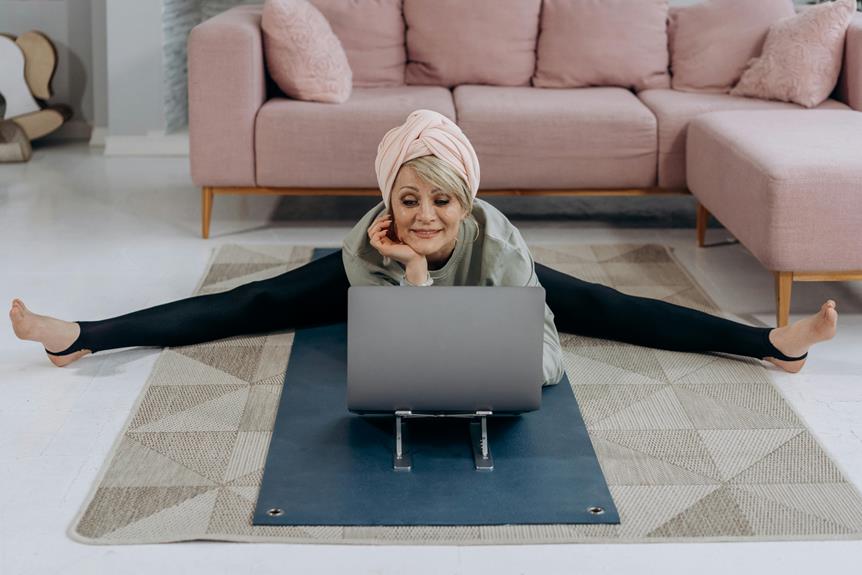
Improve your flexibility by trying out these top exercises. Engage in dynamic stretching to prepare your muscles for action and enhance blood flow. Incorporate yoga poses like Downward Facing Dog and Warrior II to target major muscle groups and advance flexibility through alignment and breathing techniques. Pilates movements such as the Hundred and Leg Circles provide controlled motions that strengthen your core and increase flexibility. Finally, consider foam rolling for muscle flexibility and tension relief. These exercises offer a range of benefits that can help you increase your overall flexibility and mobility.
Dynamic Stretching
Dynamic stretching prepares your muscles for activity by moving them through a full range of motion. This type of stretching is crucial for improving flexibility because it increases blood flow to your muscles, making them more pliable and ready for exercise.
When you engage in dynamic stretching, you're actively moving your body in various ways that mimic the motions you'll perform during your workout. This helps to warm up your muscles and joints, reducing the risk of injury during more intense physical activity.
Some common dynamic stretching exercises include leg swings, arm circles, and torso twists. These movements help to improve flexibility by elongating the muscles and increasing their elasticity.
Yoga Poses
To further enhance your flexibility and muscle strength, explore the benefits of incorporating various yoga poses into your exercise routine. Yoga offers a wide range of poses that can help improve flexibility by stretching and lengthening different muscle groups. Poses like Downward Facing Dog, Forward Fold, and Warrior II are great for targeting major muscle areas while also improving balance and stability.
Additionally, yoga poses focus on proper alignment and breathing techniques, which can help you deepen your stretches and increase your overall flexibility over time. The gentle and controlled movements in yoga also help release tension in the muscles, allowing for a greater range of motion.
Regularly practicing yoga can lead to increased flexibility in various parts of the body, such as the hips, hamstrings, and spine. Whether you're a beginner or an experienced yogi, incorporating a variety of yoga poses into your routine can significantly enhance your flexibility and contribute to better overall muscle strength and posture.
Pilates Movements
Wondering how Pilates movements can enhance your flexibility and core strength?
Pilates is a fantastic way to improve flexibility through its focus on controlled movements and proper alignment. The exercises in Pilates target specific muscle groups while emphasizing breath control and body awareness. By regularly practicing Pilates movements, you can increase your range of motion, leading to improved flexibility in your muscles and joints.
Pilates also helps strengthen your core muscles, which are essential for overall stability and balance. The core muscles play a crucial role in supporting your spine and maintaining proper posture. Through Pilates movements such as the Hundred, Roll-Up, and Leg Circles, you engage your core muscles while simultaneously working on flexibility.
Incorporating Pilates into your fitness routine can have a significant impact on your flexibility and core strength. Whether you're a beginner or at an advanced level, Pilates offers a variety of movements that can be tailored to your individual needs and goals. Start incorporating Pilates into your workouts to experience the benefits of improved flexibility and core stability.
Foam Rolling
Foam rolling is a highly effective technique for improving muscle flexibility and relieving tension. This self-myofascial release technique involves using a foam roller to apply pressure to specific points on your body. By rolling over these areas, you can help release knots and tightness in the muscles, promoting better flexibility and range of motion.
When you foam roll, focus on areas that feel particularly tight or sore. Roll back and forth slowly, pausing on any tender spots to allow the pressure to help release the tension. Incorporating foam rolling into your routine can help improve blood flow to the muscles, which can aid in recovery and reduce muscle stiffness.
Make sure to breathe deeply and relax as you foam roll, allowing your muscles to release and loosen up. Aim to foam roll regularly, either as part of your warm-up or cool-down routine. By incorporating foam rolling into your flexibility regimen, you can experience improved muscle elasticity and range of motion over time.
Conclusion
So, if you want to improve your flexibility, try incorporating dynamic stretching, yoga poses, Pilates movements, and foam rolling into your exercise routine.
These exercises will help increase your range of motion, reduce muscle stiffness, and prevent injuries.
Remember to listen to your body and progress at your own pace to see the best results in your flexibility journey.
Keep stretching and moving to feel better both physically and mentally.




